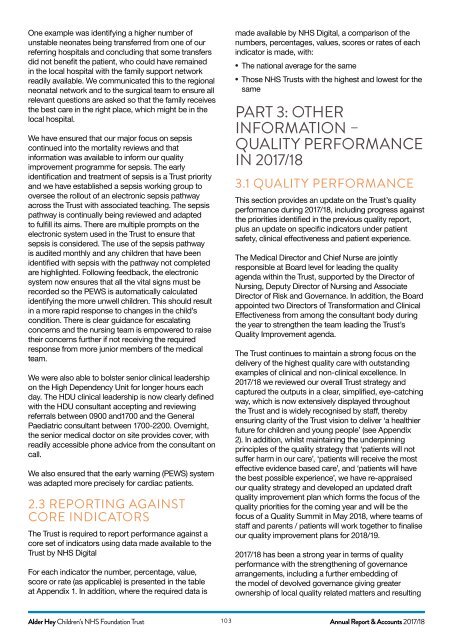AH ANNUAL REPORT 2018
Create successful ePaper yourself
Turn your PDF publications into a flip-book with our unique Google optimized e-Paper software.
One example was identifying a higher number of<br />
unstable neonates being transferred from one of our<br />
referring hospitals and concluding that some transfers<br />
did not benefit the patient, who could have remained<br />
in the local hospital with the family support network<br />
readily available. We communicated this to the regional<br />
neonatal network and to the surgical team to ensure all<br />
relevant questions are asked so that the family receives<br />
the best care in the right place, which might be in the<br />
local hospital.<br />
We have ensured that our major focus on sepsis<br />
continued into the mortality reviews and that<br />
information was available to inform our quality<br />
improvement programme for sepsis. The early<br />
identification and treatment of sepsis is a Trust priority<br />
and we have established a sepsis working group to<br />
oversee the rollout of an electronic sepsis pathway<br />
across the Trust with associated teaching. The sepsis<br />
pathway is continually being reviewed and adapted<br />
to fulfill its aims. There are multiple prompts on the<br />
electronic system used in the Trust to ensure that<br />
sepsis is considered. The use of the sepsis pathway<br />
is audited monthly and any children that have been<br />
identified with sepsis with the pathway not completed<br />
are highlighted. Following feedback, the electronic<br />
system now ensures that all the vital signs must be<br />
recorded so the PEWS is automatically calculated<br />
identifying the more unwell children. This should result<br />
in a more rapid response to changes in the child’s<br />
condition. There is clear guidance for escalating<br />
concerns and the nursing team is empowered to raise<br />
their concerns further if not receiving the required<br />
response from more junior members of the medical<br />
team.<br />
We were also able to bolster senior clinical leadership<br />
on the High Dependency Unit for longer hours each<br />
day. The HDU clinical leadership is now clearly defined<br />
with the HDU consultant accepting and reviewing<br />
referrals between 0900 and1700 and the General<br />
Paediatric consultant between 1700-2200. Overnight,<br />
the senior medical doctor on site provides cover, with<br />
readily accessible phone advice from the consultant on<br />
call.<br />
We also ensured that the early warning (PEWS) system<br />
was adapted more precisely for cardiac patients.<br />
2.3 <strong>REPORT</strong>ING AGAINST<br />
CORE INDICATORS<br />
The Trust is required to report performance against a<br />
core set of indicators using data made available to the<br />
Trust by NHS Digital<br />
For each indicator the number, percentage, value,<br />
score or rate (as applicable) is presented in the table<br />
at Appendix 1. In addition, where the required data is<br />
made available by NHS Digital, a comparison of the<br />
numbers, percentages, values, scores or rates of each<br />
indicator is made, with:<br />
• The national average for the same<br />
• Those NHS Trusts with the highest and lowest for the<br />
same<br />
PART 3: OTHER<br />
INFORMATION –<br />
QUALITY PERFORMANCE<br />
IN 2017/18<br />
3.1 QUALITY PERFORMANCE<br />
This section provides an update on the Trust’s quality<br />
performance during 2017/18, including progress against<br />
the priorities identified in the previous quality report,<br />
plus an update on specific indicators under patient<br />
safety, clinical effectiveness and patient experience.<br />
The Medical Director and Chief Nurse are jointly<br />
responsible at Board level for leading the quality<br />
agenda within the Trust, supported by the Director of<br />
Nursing, Deputy Director of Nursing and Associate<br />
Director of Risk and Governance. In addition, the Board<br />
appointed two Directors of Transformation and Clinical<br />
Effectiveness from among the consultant body during<br />
the year to strengthen the team leading the Trust’s<br />
Quality Improvement agenda.<br />
The Trust continues to maintain a strong focus on the<br />
delivery of the highest quality care with outstanding<br />
examples of clinical and non-clinical excellence. In<br />
2017/18 we reviewed our overall Trust strategy and<br />
captured the outputs in a clear, simplified, eye-catching<br />
way, which is now extensively displayed throughout<br />
the Trust and is widely recognised by staff, thereby<br />
ensuring clarity of the Trust vision to deliver ‘a healthier<br />
future for children and young people’ (see Appendix<br />
2). In addition, whilst maintaining the underpinning<br />
principles of the quality strategy that ‘patients will not<br />
suffer harm in our care’, ‘patients will receive the most<br />
effective evidence based care’, and ‘patients will have<br />
the best possible experience’, we have re-appraised<br />
our quality strategy and developed an updated draft<br />
quality improvement plan which forms the focus of the<br />
quality priorities for the coming year and will be the<br />
focus of a Quality Summit in May <strong>2018</strong>, where teams of<br />
staff and parents / patients will work together to finalise<br />
our quality improvement plans for <strong>2018</strong>/19.<br />
2017/18 has been a strong year in terms of quality<br />
performance with the strengthening of governance<br />
arrangements, including a further embedding of<br />
the model of devolved governance giving greater<br />
ownership of local quality related matters and resulting<br />
Alder Hey Children’s NHS Foundation Trust 103<br />
Annual Report & Accounts 2017/18


